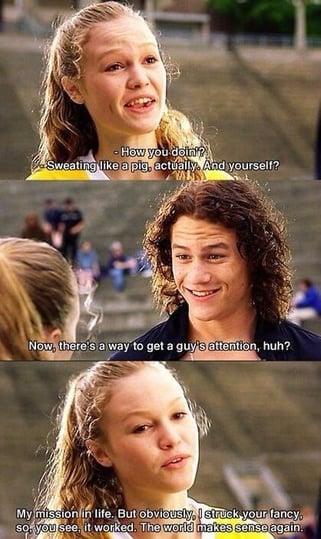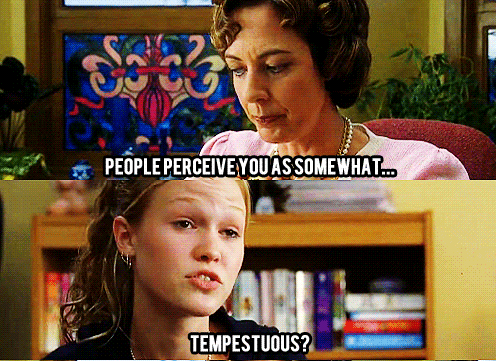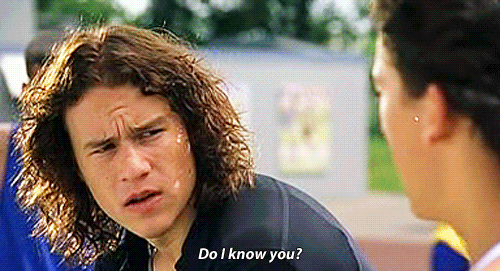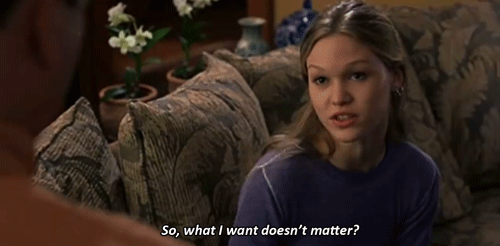“I waaaaaaant you to want me”.
Maybe you recognize those lyrics from the movie ‘10 Things I Hate About You’. And isn’t that what marketing is all about: convincing your customers to like you so much that they buy your products or sign up for your services?
And the comparisons don’t end there. We’ve turned Kat Stratford’s iconic poem into ten lessons that you can put to work in your business to improve your marketing and win over customers. Read on to learn the ten things we hate about your marketing.
1. When you don’t use your persona’s language
“I hate the way you talk to me…”
Your buyer personas’ have their own language. Every segment of your audience has their own way of talking: a certain tone of voice, particular words and phrases that they like, and possibly some language that they would never use.
Are you using that language in your marketing campaigns?
You need to adapt your message to really speak to your audience. Use their language to resonate with them instead of alienating them! Unless, of course, pushing them away is exactly what you’re hoping for.

You also need to make sure that your tone makes sense for your company. Can you get away with being silly and fun, or should you stick to formal, professional language? Use the same communication style as your most valued customers.
2. When you don’t stay true to your brand image
“And the way you cut your hair…”
No matter how you feel about Kat, she always stays true to herself. Yes, she goes through some changes, but it’s a gradual evolution that feels natural.

The same lesson should apply to your brand. Customers will get confused if you make sudden, significant changes to your messaging, visual branding, or even your values.
Instead, work on creating a consistent brand image across every platform and every customer interaction. If it’s time for your company to evolve, make sure your customers are informed about the change and consider making changes over time so the shift feels natural.
3. When you don’t understand your audience
“I hate your big dumb combat boots…”
You need to have a full picture of who your audience is, what appeals to them, and what they want to see and hear from your company.
Something like wearing combat boots (or choosing a particular image or phrase for your ad campaign) might seem minor. But it was significant enough for Kat to include her poem for Patrick. It could also be significant enough to turn off a potential customer enough that they go seek out your competitor.
Take a look at your latest marketing campaign, piece by piece. Did you consider how every interlocking factor might be perceived by your audience? Will it create a positive experience for them or push them away? If you don’t know the answer, you might need to study up on your audience a little bit more.
Need help building your buyer personas? Use this easy template
4. When you take personalization too far
“And the way you read my mind…”
Personalization is one of the most effective ways to capture your audience and make them feel like an individual. But there’s a fine line between creating a valuable, personalized experience and making your customers feel like this:
The lesson here is don’t be creepy! Customers are becoming more aware of data privacy and if you seem like you know ‘too much’ about them, you’re likely to lose trust and scare them away from ever doing business with you.
You should never use personalization just because you can. It needs to improve the customer experience, not just built into your campaigns for the sake of it. For some inspiration on how to take personalization beyond ‘Hi [first name]’, check out these 11 out-of-the-box strategies.
5. When you won’t own a mistake
“I hate the way you're always right…”
Brands make mistakes. No matter how much you proofread, no matter how in tune you are with your customers, something is inevitably going to go wrong.
What really matters is how you respond to those mistakes. It’s not enough to remove the offending post or ignore questions and comments like it never happened. You have to own up and apologize… or if you upset a particular customer, maybe you just need to buy them a guitar.

6. When you make exaggerated claims
“I hate it when you lie…”
Have you ever seen a company making some outrageous claim and thought, ‘there’s no way that can be true’?
Marketing is all about showing your customers that your products and services are amazing and how you can change their lives for the better. But even the tiniest lie can ruin your customers’ trust, upset loyal customers, and damage your reputation. That’s why you need to be 100% transparent in your marketing. Don’t make claims you can’t live up to, and always be honest with what’s going on.

7. When you don’t use emotions effectively
“I hate it when you make me laugh, even worse when you make me cry…”
Don’t get us wrong: creating emotions with your marketing is one of the best ways to stand out and create something memorable.
But there’s a time and place for making people laugh or getting them to cry. Do it tastefully and you might just take a step from ‘just another company’ to ‘a brand with real people behind it’ in your customers’ minds. But if it’s done poorly, or if you rely too heavily on negative emotions like fear, your strategy might backfire.
The most important thing to remember is that the emotion you’re creating needs to make sense for your brand. Does an emotional approach suit your company’s voice, and will it actually resonate with your audience?

8. When you don’t show up on the right marketing channels
“I hate the way you're not around…”
Potential customers are online, looking for the products and services you offer. Are you in the right places for them to discover your brand?
At the very minimum, you should have a website and a Facebook profile. Depending on your audience, there are countless other social media platforms that you can use to your advantage.
And it’s not enough to set up a new channel and forget about it! Don’t create a presence on a platform that you’re not going to regularly use as part of your bigger marketing strategy. You need to be intentional and frequently share content wherever your audience is.
9. When it’s difficult for customers to contact you
“And the fact that you didn't call…”
Billboards, radio ads, and the belief that marketing is one-way communication: all ideas from well before ‘social’ media became the #1 way for brands to communicate with their customers.
It’s not enough to provide a phone number or website contact form when people are upset. They want to be able to reach you quickly, easily, and they want a response within 24 hours… or even sooner.

Here’s how to make it easy for customers to reach you:
- Give multiple methods of contact like phone, text, email, and live chat
- Make your contact information clear and easy to find on every platform
- Never send marketing emails from a no-reply address
10. When you don’t leverage your happy customers
“But mostly I hate the way I don't hate you. Not even close, not even a little bit, not even at all.”
There are always going to be two types of customers in your business: the ones who love you and will become your most loyal supporters, and the ones who will never be happy no matter what you do.
Happy customers are your biggest asset. You can use customer reviews, testimonials, and photos to build more success for your brand and convince even the most on-the-fence buyers.
You can leverage negative followers to your advantage, too. There’s no point ‘feeding the trolls’, as they say, but you can use negative feedback as a way to improve your marketing over time and address common questions and concerns.
What do your customers hate about your marketing?
We doubt that you’ve made a marketing mistake so huge that somebody wrote a poem about it and presented it to a room full of people.
But we guarantee that at some point, you’ve irritated a customer or lost the opportunity to win over a prospect.
Marketing is all about learning from what doesn’t work and making improvements over time. If you take these lessons and start using the techniques we mentioned correctly, you’ll have 10 things that your customers will absolutely love about your marketing.



